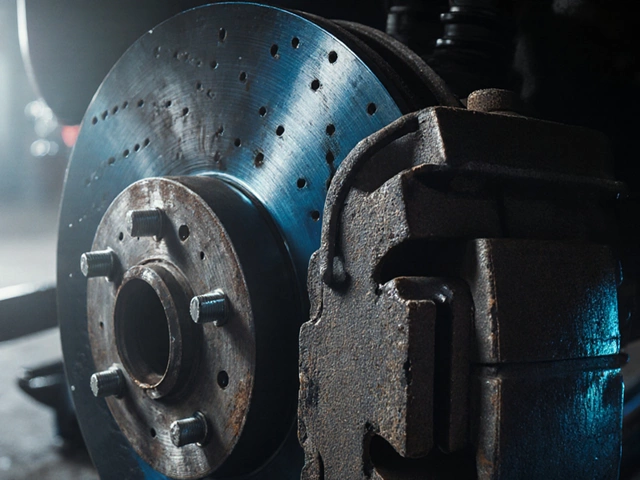Sticker shock hits fast when you ask about a radiator replacement. A lot of people hear numbers over $800 and wonder if their mechanic is just messing with them. But here's the thing: the price isn’t just about the radiator itself. You’re also paying for labor, coolant, new hoses, and sometimes even extras like a thermostat or fan switch. The type of car matters, too. Swapping a radiator on a Honda Civic is a whole different ballgame compared to a modern BMW SUV.
Skipping a bad radiator isn’t really an option, though. Wait too long, and you’re risking the entire engine. Replacing a blown engine will cost way more than fixing the radiator. So, figuring out how much you *actually* need to spend—and where you can save—is the smartest first step.
- What Drives Up the Cost of a Radiator Replacement?
- DIY vs. Mechanic: Can You Save Money?
- Extra Costs You Might Not Expect
- Tips to Keep Radiator Replacement Affordable
What Drives Up the Cost of a Radiator Replacement?
There’s a bunch of stuff that goes into that final bill for a car radiator replacement. Most people think it’s just paying for the part, but there’s much more to it. Here’s what really stacks up the price.
- The Type of Vehicle: The make and model makes a huge difference. A basic sedan can use an aftermarket radiator for around $120–$250. But if you drive a high-end, luxury, or newer import, you might be looking at $400–$800 just for the part. Some cars have radiators crammed into tight spaces, meaning more time and skill to swap them out.
- Labor Costs: Mechanics charge by the hour, and radiator jobs can range from 1.5 hours to 5+ hours, depending on how easy it is to get to everything. Nationally, labor runs about $75–$150 per hour at most shops.
- Parts Prices: Besides the radiator, you usually need new coolant, hoses, clamps, and maybe even a new thermostat. OEM (original equipment manufacturer) parts cost more than aftermarket, but they’re often the safer bet for pricier cars.
- Region: Repair shop rates can jump up if you’re in a big city or in a state with higher labor rates. It’s not uncommon for a radiator job in Los Angeles or New York to run at least 30% more than a smaller town.
- Extra Repairs: If there’s corrosion, cracked hoses, or failed fans found during the job, expect to pay extra. Sometimes a mechanic spots leaks or thermostat issues that should get fixed at the same time, saving cash and time down the road.
To give you a quick idea of what you might pay, here's a table comparing some typical costs from 2024:
| Vehicle Type | Parts (USD) | Labor (USD) | Total Cost (USD) |
|---|---|---|---|
| 2009 Honda Civic | $160–$220 | $120–$180 | $280–$400 |
| 2017 Ford F-150 | $220–$370 | $200–$350 | $420–$720 |
| 2022 BMW X5 | $540–$900 | $350–$600 | $890–$1,500 |
So the bottom line? Your car type, where you live, and the parts you choose dictate how much you’ll end up spending. Knowing what drives up costs lets you ask the right questions before handing over your keys—or your credit card.
DIY vs. Mechanic: Can You Save Money?
It’s tempting to tackle a car radiator replacement in your own garage, especially when you check online and see that the part alone can run anywhere from $80 to $300. Compare that to $600 to $900 for the full job at a shop, and the car radiator cost difference is obvious. But before you grab your tools, there’s more to think about than just the price tag.
If you’re handy and have done some basic car repairs—think oil changes, brakes, or a thermostat swap—swapping out a radiator is within reach. Most setups involve draining the coolant, removing a few hoses, disconnecting the fan or sensors, and sliding the old radiator out. With the right tools and a weekend afternoon, you might save hundreds. Plenty of folks share their exact steps and video guides online, especially for popular models like the Toyota Corolla and Ford F-150.
- DIY parts cost: Most radiators range from $80 to $300. You’ll also need new coolant ($20–$40), and sometimes new hoses or clamps ($10–$50).
- Mechanic labor: Mechanics charge $100–$300 for labor (or $80–$200 per hour) because they’ll flush old coolant, check for leaks, and make sure everything fits right.
But here’s what stops a lot of people: newer cars have tight engine bays, extra sensors, and complex cooling fans. One misstep—like pinching a sensor wire or using the wrong coolant—and suddenly you’re facing more headaches and extra bills. If your radiator swap comes with a mess of hose clamps, electrical connections, or transmission cooler lines, seriously think twice before going solo.
For most simple, older cars, a radiator swap is one of those rare DIY jobs that actually makes sense. For newer rides loaded with tech, paying a pro keeps things safe—and could even protect your warranty. Always check if your parts are covered before cracking open the hood. If you don’t have the tools or patience, call a shop for a quote, and make sure it includes everything: parts, labor, coolant, taxes, and shop fees. A cheap quote can jump fast with hidden extras.

Extra Costs You Might Not Expect
When you budget for a car radiator replacement, plan for a few surprises. The biggest mistake? Thinking you’ll just pay for the radiator and some labor. Modern cars usually don’t make it that simple. Sometimes, repair shops find other problems while they’re already under the hood, which racks up the bill fast.
One of the most common extras is new coolant. After taking out your old radiator, the shop has to refill the cooling system. A full coolant flush usually costs $50-$100. Skipping it can wreck your new radiator since leftover sludge or rust can clog it up almost overnight.
If your car’s radiator hoses are old or cracked, shops will likely swap them out. A new set of hoses can add $35-$80, plus a few extra bucks for clamps. You might also get hit with charges for a thermostat ($30-$60) if your engine’s running hot or the mechanic notices it’s sticking. Some cars have a cooling fan sensor, and if that’s on the fritz, throw in another $40-$100.
Labor makes up a big chunk of the cost. If your car is a pain to work on (think tight engine bays or lots of engine covers), you could see labor charges shoot up to $500 for European or luxury vehicles. Compare that to $150-$300 for older, simpler cars.
| Possible Extra | Estimated Cost (USD) |
|---|---|
| Coolant Flush & Refill | $50 - $100 |
| New Radiator Hoses | $35 - $80 |
| Thermostat Replacement | $30 - $60 |
| Fan Sensor/Switch | $40 - $100 |
| Additional Labor (Complex Cars) | $200+ |
If your radiator leaked for a while, check your heater core too. Sometimes, gunk from a dying radiator clogs or corrodes other parts of your cooling system. The last thing anyone wants is to pony up for a new heater core just weeks later.
Don’t forget shop fees and taxes, either. A lot of garages tack on a standard 5-12% fee to cover rags, cleaning supplies, and disposal. Add sales tax, and the small stuff can add up to $50 or more. Always ask for an itemized estimate so you can see where every dollar is going.
Tips to Keep Radiator Replacement Affordable
Let’s be real—no one wants to drop a ton of cash on a car radiator unless they have to. But there are solid ways to avoid those eye-watering repair bills that come with surprises. Here’s how you keep that wallet from thinning out.
- Car radiator parts come in “OEM” (original equipment manufacturer) and after-market options. OEMs usually cost more, but after-market radiators often fit just as well for way less. Always check reviews and ratings before pulling the trigger; the savings can be big enough to cover a nice dinner afterward.
- Get multiple quotes for the job. One shop’s price can be shockingly higher than another’s, even in the same area. Use apps or just call around—it’s worth the ten minutes.
- You don’t always need to replace the entire radiator. Sometimes, fixing a leak or swapping a hose does the trick. Ask straight-out if a simple repair could cut costs, especially if your car isn’t losing coolant too quickly.
- Buy your own parts and just pay for labor. Plenty of garages will install a part you bring in, and you’ll skip their markup. Just make sure the shop’s cool with this before showing up with a big box.
- Stay ahead with regular checks—pop the hood every few months and look for leaks, corrosion, or coolant spots on the driveway. Fixing a small problem early always beats waiting until things explode—literally and financially.
According to a 2024 AAA survey, “Drivers can save up to 20% on auto repairs by comparing quotes and considering trusted independent shops instead of always defaulting to the dealer.”
Mechanics at Consumer Reports note, “Sometimes a new radiator isn’t needed. If you catch a minor leak early, a pressure test and a simple fix can save you hundreds.”
One last thing: pay attention to your warranty. Some radiators (especially in newer or certified pre-owned cars) are covered if you’re still within the warranty window. That’s a zero-dollar fix—not a bad deal at all.




